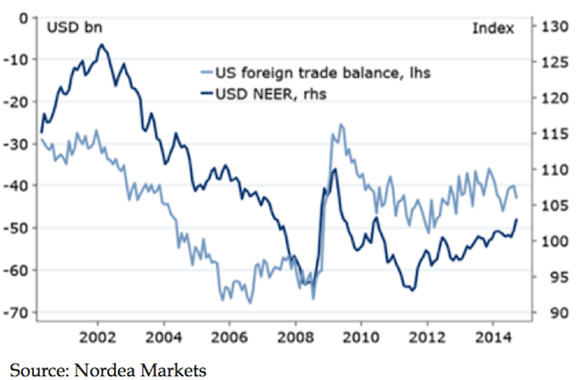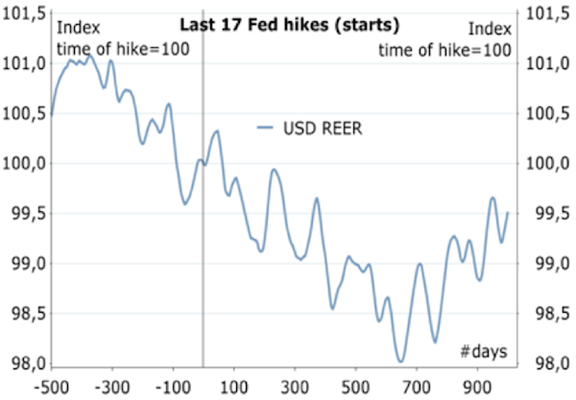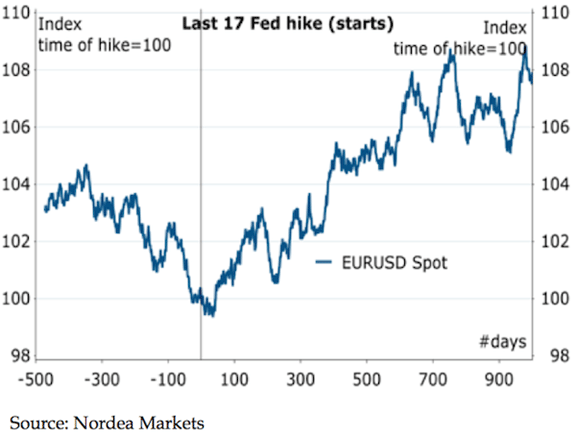US Dollar - Americas Phoenix
Currencies / US Dollar Mar 25, 2015 - 02:26 PM GMTBy: John_Mauldin
 “Just a little patience, yeah…” - Guns N’ Roses
“Just a little patience, yeah…” - Guns N’ Roses
Lastweek the FOMC essentially removed forward guidance and placed all options back on the table, and at the end of the day they’ve opened the door for further tightening. As Yellen recently explained in advance, the removal of the word patience from the Fed’s guidance amounts to fair warning to the rest of the world’s central banks: an interest rate hike is on the horizon. Govern your actions accordingly. (My personal guess, for those interested, is September, with the Fed proceeding exceedingly slowly and cautiously thereafter.)
The bigger story here is the sustained strength of the US dollar, which has traded wildly in the FOMC’s wake. A correction to the one-way trading prior to the meeting was well overdue and could last some time, but then the dollar strength will resume. (Euro) Parity or Bust! My young colleague Worth Wray and I have been writing for some time about the risks this trend poses, to emerging markets in particular, and now it seems that nightmare could happen sooner rather than later.
We’re already seeing profound FX pressures on countries like Russia, Brazil, Turkey, and South Africa, among many others; but, while clearly exacerbated by the strong dollar and/or weak commodity prices, recent stress in various emerging markets appears to have more to do with internal troubles than external shocks. Nevertheless, the dollar’s strength has not been fully absorbed by EM economies, so a BIG, broad-based, dollar-driven adjustment may be yet to come.
Until this Wednesday’s FOMC press conference with Janet Yellen, the growing consensus was that an eventual interest rate hike would lead to an even stronger USD. Now it seems most observers, including our own Jared Dillian, are doubting that a rate hike will come this summer… or anytime soon.
Worth and I have a different view. We believe that Federal Reserve Vice Chair Stanley Fischer has carefully laid out a framework for interpreting the FOMC’s opaque communications as the committee moves closer to a rate hike. In a speech last October, Fischer made it clear that the Fed would “recognize the effect of (its) actions abroad and … minimize the negative spillovers (those actions will likely have) on the global economy” by clearly communicating its policy intentions in advance. If you read between the lines, the only way the Fed can give foreign central banks the opportunity to prepare for the likely FX shock that would follow a rate hike is to send the message in a way that the market does not immediately understand as overtly hawkish. This week’s announcement makes perfect sense when looked at through that lens.
Translation: while the FOMC’s decision to hike interest rates remains data-dependent, the Fed has opened the door for further tightening as soon as June 2015. That could be terrible news for a number of emerging markets, but none of those countries can credibly complain that the Fed is responsible as capital flees their economies in search of safety and more-attractive risk-adjusted rates. Emerging markets are not a homogenous group, but even the best positioned countries like the Philippines are at risk in the event of a broad-based contagion. We’ve seen that dynamic play out repeatedly in the 1980s, the 1990s, and the 2000s. It may be time for another hurricane.
With our expectations on the table, Worth and I still have to ask… what if we’re wrong? What if the dollar doesn’t strengthen? We’ll consider that scenario in today’s OTB.
It’s a real pleasure for me to introduce today’s author, because this OTB is also the perfect opportunity for an announcement I’ve been wanting to make for some time: Jawad Mian has brought his excellent research service, Stray Reflections, to Mauldin Economics. You can learn more about his service here. His “transparent hedge fund” approach to investment research is unique, well-reasoned, and decidedly non-consensus. And his prose is unrivaled.
Today’s OTB is taken from Jawad’s top 10 investment themes. These are the themes around which he builds his portfolio. I agree with many of his ideas, but I offer up this particular piece as an example of one where I remain unconvinced, if not in outright disagreement. Yet… Jawad makes such a strong argument for the dollar’s weakening. We have exchanged emails and dueling notes of late (but in a very collegial fashion).
I have to admit, I am NEVER comfortable when this much of the crowd agrees with my view, as they seem to now. A serious correction of the recent trend in dollar strength is clearly due, but what if – as Jawad argues – we are seeing a major shift to an entirely new macro regime?
It’s worth noting that Jawad made this weaker dollar call several months ago. HSBC analysts and others are beginning to agree with him. The US dollar is the single most important factor in global macroeconomics; so do your homework, consider the antithesis to your closely held beliefs, and ignore Jawad’s thoughtful analysis at your own risk.
I was in Switzerland for the last week, meeting clients and speaking in Zürich. I kept asking the question, “Where is Draghi going to get €60 trillion in European bonds, month after month?” He is reportedly already behind the curve for this month’s purchases. I get no satisfactory (to me) answer. Maybe he does, but he wants to buy more than governments are issuing, and no pension company or insurance company is going to be able to sell him their bonds if they have a positive yield. Maybe he gets creative in what he buys. I will write more about this over the next weekend, but we are in the Twilight Zone for bonds. French yields are negative out to five years, and to get 1.5% you have to buy a 50-year French bond? Can anyone do that and seriously be considered a prudent fiduciary? Have you looked at France’s balance sheet and total commitments, not to mention the country’s politics? And don’t even get me started on the rest of Europe. Half of Northern Europe’s debt has negative yields.
I had the very real privilege of having dinner with William White, former chief economist of the Bank of International Settlements and currently consultant to seemingly everyone. He will be at my conference this year as the final speaker, and it will be a very impactful speech. On several occasions during dinner, I got him to agree to say in public what he said in private Tuesday night. I have long been a fan of his candor and style, and that evening I felt like a student. He is now my favorite (ex) central banker.
I want to thank so many of you who wrote to me expressing your condolences about my Mother. It meant a lot. Truly.
My sister flew in from Victoria Island, where she lives with her sons. I cornered her the first night she was there and told her that her other brother wanted us to sing at the graveside the lullabies that mother sang to us as children when she put us to bed (and which we all vividly remember). I tried to convey the clear impression that I thought it was a bad idea, but I was amazed that she agreed with him. “I think it is a marvelous idea, and mother would agree. You will do it.” How can you tell your little sister no when she looks at you that way? So, there I was, singing in the rain, or trying to. I don’t think I actually made it to the end of “Tura Lura Lural.” In the moment it was much more than an old Irish lullaby.
Your doing a lot of pondering analyst,
John Mauldin, Editor
Outside the Boxsubscribers@mauldineconomics.com
US Dollar: American Phoenix
By Jawad Mian
A New Religion
Divergent monetary policy, interest rate differentials, and growth trajectories favor the US over Europe and Japan. This has become the key investment theme for global investors. Foreign flows into US financial assets hit a record last year while traders’ speculative long positions in the dollar reached a new all-time high. It is believed the US dollar has begun a multi-year mega-uptrend. The faith in broad-based dollar strength is supported by (1) decent US growth, (2) higher yields than those of its main trading partners, (3) external balances that are in good shape, (4) cheap currency valuation on a real effective exchange- rate basis, and (5) deliberate devaluations in the rest of the world. Based on AKSIA’s Hedge Fund Manager Survey, 86% of the 187 managers polled expect the US dollar to be the top performing currency in 2015. So today, the dollar index is up 23% from its 2011 low, which, ironically enough, coincided with the S&P rating downgrade of US credit. But can this strength endure, as it did in the 1980s and 1990s?
Those two late-20th century upward moves in the dollar came in times of robust US growth and relatively tight monetary policy. The rally was further bolstered by risk aversion flows given periodic waves of uncertainty around the world.

We are skeptical of the consensus mindset and don’t think that the US dollar can appreciate significantly over the next five years. We view the dollar’s recent strong run-up as a cyclical phenomenon—not a secular upturn—and suspect it offers a great opportunity for investors to diversify outside of the dollar. While we believe that the US economy can withstand short-term rates above zero at this point, the anomalous divergence between payrolls growth and inflation expectations complicates the way forward. The global macro environment today is beset with deflationary tendencies. Based on our best judgment, monetary policy is unlikely to tighten at the pace it did during the previous cyclical dollar bull markets of the early 1980s and late 1990s. Measures of long-run inflation expectations based on the CPI swaps market have fallen below levels that preceded QE2, QE3, and Operation Twist. If deflation expectations accelerate, or in the event of any negative growth surprises, we believe the Fed will be forced to adopt a more relaxed attitude toward policy normalization than is currently anticipated.
Investors have also greatly overestimated the resilience of the US recovery, especially when we consider the prospect that we may have seen “peak payrolls” in November. Over the coming year, we think the labor market will be demonstrably weaker than indicated by the unemployment rate, as the pace of job growth stalls. It certainly looks like US GDP peaked in Q3 2014 on a sequential basis. According to BCA Research, the biggest boost from the most cyclical parts of the economy—housing and consumer durables—is already behind us. The labor market usually peaks 7 months in advance of a recession. Based on the Fed’s models, a large appreciation of the dollar is estimated to cut GDP growth by around 0.5% over the following year. We think the Fed’s priority of containing any unwarranted rise in bond yields may be displaced by its monitoring the rise of the dollar. We also observe that a positive co- movement has developed between the trade- weighted dollar and US stocks, which suggests that the dollar may not be the usual safe haven if equity markets slide.
American Hustle
One of the less-cited factors for dollar strength is the improvement in the US current account. The chief benefit of QE was the cheapening of the dollar to its lowest level in the postwar era. It was among several factors that led to a decline in the current account deficit from a peak of 6% of GDP in 2006 to about 2% of GDP in 2014. It was partly the reduction in the current account deficit that led to fewer US dollars being available in the global market, thus swelling the dollar’s value. The “short squeeze” on two-thirds of the $11 trillion cross-border loans that are denominated in dollars reversed institutional investment flows back into the US, according to Morgan Stanley. The last time the US had a current account surplus was in 1991, when the trade-weighted dollar was nearly 40% stronger than it is today. So the fact that even with the dollar’s major undervaluation since 2011, the US has been unable to return to a surplus suggests that the current account deficit is really structural in nature. We think the dollar is now vulnerable to a rewidening of the current account deficit on the back of stronger household consumption.
The temporary fillip to the current account from the shale oil boom, weak import demand, and lower interest rates should reverse in the next five years. The US trade deficit is already back to the record lows seen before the financial crisis in 2008, if we exclude oil. Even with the drop in oil prices, US terms of trade will benefit less, due to much lower sensitivity relative to history. It is for this reason that we believe the US will struggle to attract the same amount of external capital as it has in the past.

The Most Important Chart
By reviewing past tightening cycles, we observe that exchange rates can follow many paths that do not always correspond to the predictions from monetary policy actions. For instance, the Fed’s last tightening cycle began in mid-2004, when the unemployment rate had fallen to 5.5% and other labor market metrics were significantly stronger than they are now. The US dollar fell in the following six months, and by the time of the last rate hike during the summer of 2006, the dollar was at about the same level as when the liftoff began. Over an extended period of time, rising US interest rates are not necessarily accompanied by a rising foreign exchange value of the US dollar. Fed rate hiking since the early 1970s has actually been, on average, consistent with the dollar getting weaker, not stronger.


Like Outside the Box?
Sign up today and get each new issue delivered free to your inbox.
It's your opportunity to get the news John Mauldin thinks matters most to your finances.
John Mauldin Archive |
© 2005-2022 http://www.MarketOracle.co.uk - The Market Oracle is a FREE Daily Financial Markets Analysis & Forecasting online publication.



